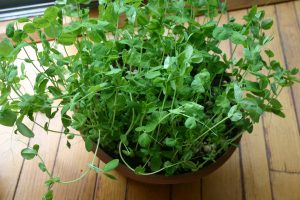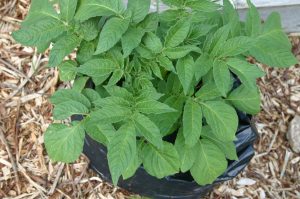
With the cost of produce steadily rising, greenhouse owners may want to try growing their own vegetables this winter. Quite a few plants will continue growing in cool conditions as long as they don’t freeze. The minimum temperature in your greenhouse should be somewhere above 40°F during the night and on cloudy days, although at least 50°F will we less stressful and generally spur faster growth. As for which plants to choose, some will grow better than others in cool temperatures, but in general you have a sizable selection to choose from.
You might start by growing something very easy – microgreens. These are edible leafy plants harvested in the seedling stage when they are still very small. Restaurants often use them to garnish their plates, but they also make delicious additions to salads, sandwiches, and smoothies. Microgreens grow very quickly, have good flavor, and offer the peak of nutritional value because very young plants are nutrient rich. Mustard, chard, kale, broccoli, and broccolini are among the choices, although other plants with small seeds can be excellent choices too. All you need is a shallow tray about 2” deep filled with potting soil, plus a packet of seeds and some water. Sow the seeds thickly to get a dense stand of upright plants that are picked when they’re only about 2” to 3” tall.

If microgreens aren’t your preference, the next step up in size may be. These are mini greens, which are grown to a height of about 4” to 6”. Mini greens can easily be cultivated in any tray or pot that is 2” to 4” deep. Because they are larger than microgreens, they’re particularly useful in salads. In addition to the plants mentioned for growing microgreens, a number of others are suitable for mini greens, including lettuce, pea shoots, and Asian greens, such as Pak Choy, Mibuna, Bok Choy, Tatsoi, and Shungiku. Just as with microgreens, you should sow the seeds thickly to get a dense stand of plants that will be ready to harvest in a short time. Exposing your mini green plants to 3 or 4 hours of extra LED light during the short days of winter will help them to grow a little faster. You can pick the entire mini green plant when it reaches a suitable height, although with pea shoots, pick only the top leaves.
Your winter greenhouse veggies need not be restricted to greens. If your greenhouse has a growing bed, you can start carrots, parsnips, and turnips in mid to late summer, with the aim of harvesting them during the winter months. Leaving them to grow in the greenhouse as winter’s chill proceeds will give you a progressively larger yield, although the growth of these root crops will be quite slow.

Other plants sowed in mid to late summer can also overwinter in a cool greenhouse. These include cabbage, broccoli, leeks, scallions, radishes (both red and Daikon), and many kinds of herb. Yes, in summer they will need to be watered frequently and will grow slowly in the heat, but as temperatures drop, the conditions will suit them much better, and you can harvest them for your table virtually all winter long. You must use them up before spring, however, because in spring any remaining plants will quickly go to seed.


